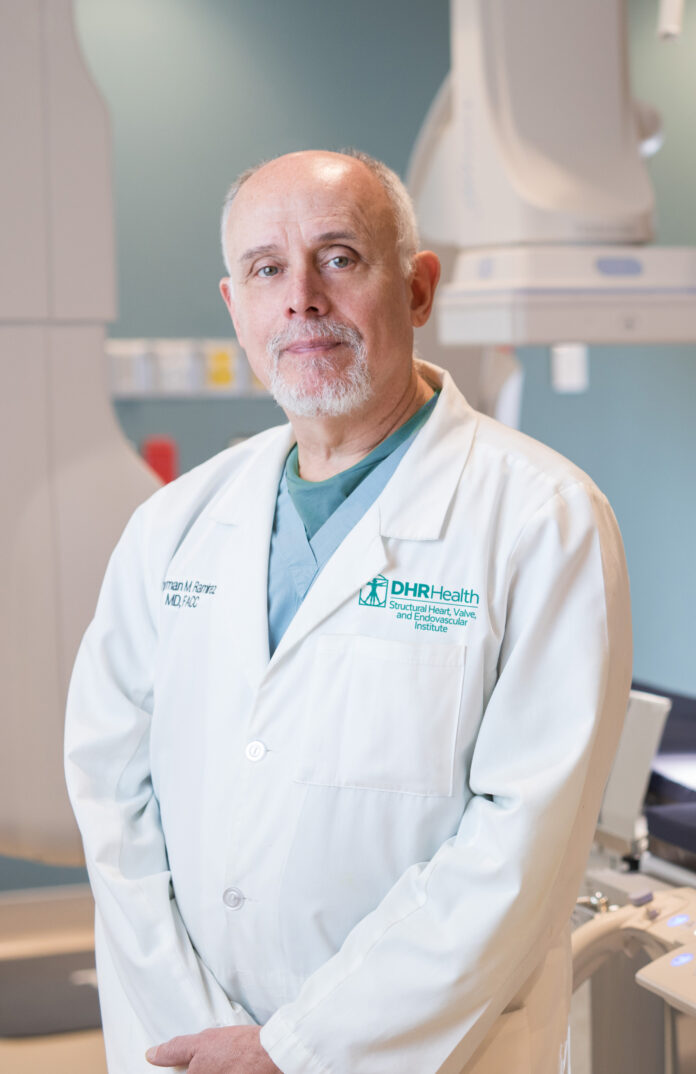By: Norman Ramirez, M.D., F.A.C.C.
DHR Health Structural Heart, Valve and Endovascular Institute
Structural heart disease refers to diseases involving the actual structure of the heart, that can often be life threatening, and previously required surgery to repair and treat. A very exciting area of cardiology today is the treatment of structural heart diseases using minimally invasive/catheter based techniques to avoid open heart surgery.
The most common structural heart problem currently being treated is aortic stenosis. This occurs when the heart valve that lets blood out of the heart, to circulate throughout the body, becomes stenosed or blocked. The valve progressively becomes more scarred, then calcified, and with time the opening of the valve gets smaller…often to the size of a pinhole. As the valve increasingly becomes more blocked, it can cause symptoms of shortness of breath, dizziness, chest pain, and even death. This condition previously required open heart surgery to replace the heart valve, but can now be treated with a minimally invasive procedure called TAVR (trans catheter aortic valve replacement). With the TAVR procedure a new stent valve is inserted through an artery in the leg, the femoral artery, and placed across the stenosed valve. This forces the patient’s own blocked valve to open. Within the stent, there is a new porcine/pig valve in place that begins to function immediately, replacing the prior diseased valve. This procedure works very well, typically causes minimal discomfort, and only 1-2 days in the hospital. Symptoms are usually relieved immediately.
Another common structural heart problem is mitral regurgitation. This occurs when the mitral valve, one of the heart valves that prevents blood from flowing back into the lungs when the heart contracts, begins to leak. As the valve leakage worsens, the lungs fill with fluid, and patients experience shortness of breath, often severe. This disease also previously required heart surgery to repair or replace the valve, but there is a new catheter based technique called Mitra Clip that allows a physician to repair the valve and reduce the leakage significantly. In this technique, a catheter is placed through a vein in the leg, and threaded through the heart across the leaky valve. A “clip” is then placed on the valve to support it, and reduce the leakage. This is similar to a surgeon sewing the valve to reduce leakage, but is done without requiring the chest to be opened.
A different structural heart issue occurs when a patient has persistent atrial fibrillation, which is a problem characterized by a very irregular heartbeat. This places the patient at risk of forming clots in the heart, which can break off and cause major life threatening/disabling strokes. Typically, patients are placed on strong blood thinners for this problem, but many patients cannot tolerate blood thinners due to recurrent anemia/low blood counts, or bleeding issues. Another minimally invasive catheter based technique used to treat this issue is the Watchman device implant. This technique uses a form of filter that is implanted in the area of the heart where clots most commonly form, again through a catheter inserted through a leg vein. The Watchman device prevents clots from forming, and breaking off, therefore preventing strokes from occurring. Once the filter is implanted, patients can be taken off blood thinners.
DHR is currently the only hospital in the Valley performing the full range of structural heart procedures.





